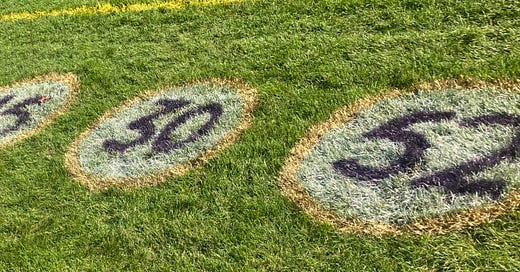Senior Night: Lessons for Navigating the Rest of the Journey
The role of high school sports in personal development
Senior Night. The yearly and seasonal ritual in high school sports where senior athletes (year 12) are recognized and often joined by parents, guardians and/or family members on the field or court before competing in their last home game.
Almost 8 million U.S. high schoolers compete in sports annually, which is about 1 in 3 high school students overall and about 38% of boys and 30% of girls. Once Senior Night and the season is over, only about 7% of high school athletes (about 1 in 13) go on to play in college - with this percent varying by sport (e.g. 14% boys lacrosse, 12% girls field hockey, 3% wrestling, 4% girls volleyball, etc.). And clearly, the odds of advancing to the professional level for those playing college sports decreases significantly. For example, there are about 1 million high school football players annually, and eventually 250 or so or 0.023% make it to the the NFL.
Potential Benefits of Participation in High School Sports
Participation in youth and high school sports offers the potential for a range of positive benefits for physical, psychological, and social development of the adolescent, especially when participation is structured to emphasize personal development and not just performance and competitiveness.
Here are some key findings from relevant research:
Physical health: Engaging in sports enhances cardiorespiratory fitness, muscular strength, and overall physical fitness and wellness, contributing to long-term healthy lifestyles (Bergeron, 2007).
Psychological benefits: Youth sports participation is linked to improved self-esteem, resilience, and emotional regulation, especially when programs emphasize fun and personal growth over competition (Young, 2012).
Social development: Sports foster teamwork, communication, and leadership skills, offering a context for positive social interactions and peer relationships (Gould & Voelker, 2012).
Academic outcomes: Sports participation is also associated with better school engagement and motivation, helping youth balance physical and academic efforts (Fitch et al., 2016).
Again, these are the potential benefits of participating in youth and high school sports. The positive benefits of sports don’t come automatically. Coaches and athletic directors and other stakeholders need to be mindful and purposeful with designing the overall program and training environment. Over the years, we have all seen some great programs that accomplish the above … and have also seen several that fall quite short.
Even within those schools and programs that accomplish the objectives of developing the desired physical, psychological, and social characteristics during the adolescent years, it becomes perhaps more important that these are carried forward into the transition of young adulthood and throughout adulthood. Again, we all have seen those who continue these positive habits and traits and other former high school athletes who fall short. Consistency and discipline is key.
After the Final Whistle: Keeping Your Athletic Dreams Alive
As mentioned, a select group of high school athletes will continue onto college sports. But eventually, for all of us, the ball will stop bouncing and the final whistle will sound. But that doesn’t mean we should stop being an athlete and lose our athleticism.
After Senior Night, there are several ways to continue to actively participate in sport and movement. In college, some participate in intramural sports and/or recreational programs. As we transition into adulthood and take on job and family responsibilities there are still recreational opportunities whether it be formal (adult soccer league) or informal (noon ball). Others resort to an active lifestyle of training and conditioning including walking, jogging, and resistance training.
In a recent post, I wrote about The High School Has-Been and Staying Active in Adulthood. Here are a few key points for keeping your athletic dreams and yourself alive and living a healthy life. When followed consistently, it will reduce the risk of a premature final Senior Night and final whistle of life - i.e. death.
Aerobic exercise [4x/wk 45min in Zone 2 or 60-70% of your maximum heart rate or at a pace that is easy, able to have a conversation - talk test; plus 1-2x per week high-intensity intervals]. This could be daily walk/jog/bike and participation in noon ball or soccer league, etc.
Strength Training. Lift heavy; squat or deadlift, hinge, push and pull, grip (Farmer’s Carry), hang, and sometime ruck. 2-3x per wk
Stability a few times per week before or after training or as recovery day
And don’t forget ….
🥣Nourish yourself well with the right types of food, in the right amounts, and at the right time. Pro Tip: Shop the perimeter of the grocery store. This is where you find whole/unprocessed foods - meats, dairy, whole grains, fruits and veggies.
😃Laugh, smile, and find your Inner Circle.
🧠Think and engage the brain and mind.
🛏️Recovery and Sleep.





